Newsletter
Autumn 2012

Newsletter |
 Aconitum napellus
|
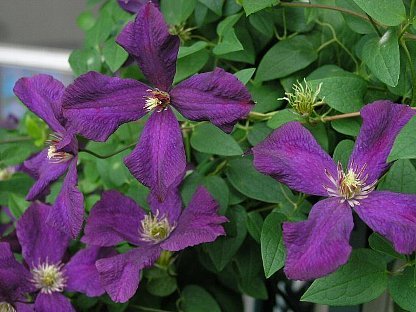
What a year we've had – first drought, then what has seemed like continuous rain. The garden is like a jungle – everything has grown larger and lusher than usual and the slugs and snails have had a field day. I read somewhere that they don't touch aconites. Have I got news for whoever wrote that! In fact there doesn't seem to be much they won't have a go at including my runner beans. My outdoor tomatoes got blight but luckily the greenhouse ones have escaped and cropped earlier this year than last, ‘Sungold’ starting in July. Yet again I proved that my fingers are less than green when it comes to clematis as ‘Mrs Cholmondeley’, one of my rare successes, died and ‘Etoile Rose’ never bothered to start! ‘Polish Spirit’ hangs on but doesn't flower so I have potted it up while I consider what to do with it, and my C. integrifolia and C. recta ‘Purpurea’ have vanished in the jungle. Perhaps I shall find them when I have my autumn tidy up. I am now busily gathering seed for the HPS seed bank and will be able to return some from plants grown from HPS seed last and this year. If you haven't tried this, do have a go. You may not get what it says on the packet – my Papaver spicatum turned out to be Welsh poppies – but it's a good and cheap way to try something out of the ordinary.
We seem to have had a really busy summer activity-wise. I hope you have enjoyed the various trips and activities that were organised this year: two excellent days out to gardens in Herefordshire and Gloucestershire, luckily with dry weather; a wine and cheese evening at World's End Nursery where we had the opportunity to admire Robin and Kristina Pearce's garden; coffee mornings at Alwyn Stanley's and Hazel Bartlett's who kindly opened their gardens for us; a plant sale which we hope to repeat next year (and a big thank you to all who took part and/or donated plants); a stand at Spetchley Plant Fair (where I froze for the whole day and the stall had to be dismantled during hail and thunder) and our stand at Malvern Spring Show which won a First Prize; and not forgetting our usual meetings with speakers. On a sad note we learned of the untimely deaths of two members, Mike Hawcutt and Margaret Boulton, and we sent our sincere condolences to their families.
If you would like to help at any of our activities please don't hesitate to speak to any of the committee. We would be delighted to welcome you. We shall also be looking to elect a new committee in March, including a new treasurer. Please consider standing if you feel you could contribute in any way.
Happy gardening.
Subscriptions to the Group become due on 1st January 2013 and can be paid either on the door at a meeting or by post to my address at Half Acre, Main Street, Worcestershire, WR11 7XB. Cheques to be made payable to ‘HPS Worc's Group’. The sub remains the same at £12.50 and admission to the meetings is free. It would be helpful if you are able to give me a post-dated cheque at our December 2012 meeting. This would ease the burden on the door in January 2013. Remember membership of the Group is conditional on being a member of the national Hardy Plant Society.
A big thank you to everyone who has contributed material, or provided advice and support, for this Newsletter. This is the first time I have ever done a Newsletter, so it has been a little nerve wracking, but I hope you enjoy it. Please keep your contributions coming – long or short, sweet or ‘serious’. Copy deadline for the Spring 2013 edition is 9 February.
Why do slugs and why do snails
Leave such pretty silvery trails?
For they are not nice at all
Climbing up my garden wall
Waiting for the night to fall,
Lurking under hedges.
They are not fussy what they eat,
Runner beans or tender beet,
Sweet peas and petunias fair,
They munch them all without a care.
My beans are minus all their leaves,
Lettuce gone for good.
Delphiniums, lupins share their fate
And no strawberries for my pud!
‘What to do?’ I ask myself,
A mallet comes to mind.
But thoughts of that disturb me so,
For I am not unkind!
I try the usual ‘humane’ route
of eggshells, copper, beer,
But still they come in massive droves,
They really show no fear!
There are so many of them,
And only one of me,
Of my hard work they’re unaware
And not welcome - can’t they see?
Next year I hope they’ll go elsewhere
And leave me well alone
To enjoy my flowers, fruit and veg
That I’ve so carefully sown!
As usual, every late summer/early autumn I have friends comment on the lack of colour in their gardens at this time of year. I despair! I think my garden is almost as colourful as it was in June – there are so many useful and easy plants that will help to maintain a colourful bed or border through this time of year, which I’m fairly sure most Hardy Planters would agree with.
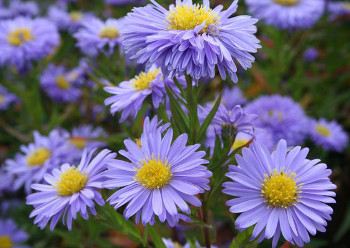
Anyway, I’ll mention a few plants that are giving me great pleasure at the moment (late September). The blue and white bed is living up to its name – a lovely Michaelmas daisy that I have had for many years, ‘Marie Ballard’, which is a lovely true powder blue, has grown into a large clump which will have to be split next spring, plus a darker blue one (whose name I have never known!) is doing splendidly. Some late agapanthus are still in flower and that stalwart of the front of the border, Viola ‘Eastgrove Blue’, is doing well after a ‘chop’ in early August. A lovely white cactus dahlia, ‘Baret Joy’, is taller than usual (due to the heavy rainfall I suspect) and is very floriferous. Lobelia syphilitica has been good too, again due to more moisture I suspect, and is only just going to seed. Until this week, the salvia-like Strobilanthus atropurpurea (sorry, don’t know a common name) has been splendid. The pretty herbaceous clematis, C. ‘Annabelle’, has been flowering since late June and still has a bud or two to open.
The ‘hot bed’ is also bright and cheerful – several dahlias, including the ubiquitous ‘Bishop of Llandaff’, have been flowering for weeks and still have a lot of buds to open. Crocosmia ‘Severn Sunrise’ is a lovely clump of apricot/orange and also C. ‘James Mey’ has done well this year. A new dahlia purchased from Bob Brown is proving interesting too – D. ‘Tonka Surprise’ (it certainly was!). A lovely double cactus dahlia, ‘Orangestadt’, is splendid and a favourite of mine. It is a lovely orange/yellow.
The main borders are colourful with Michaelmas daisies and more dahlias whose names I don’t know since I have had them for many years as gifts from family/friends - who didn’t know the names either! Lobelia vedrariensis has been super, a lovely purple spike up to 3ft in some clumps. A good combination with a dark crimson dahlia, ‘Purple Haze’, which has dark leaves. Verbena bonariensis has grown well, and is interspersed amongst the Michaelmas daisies and dahlias. Several hardy fuchsias are doing well, and make a lovely splash of colour along the front of a wall. Deep blue Aconitum carmichaelii has only just started to flower and is always dependable until mid-October.
So – if only we can have some lovely autumn days with warm sunshine, the garden will continue to be colourful for a few weeks yet.
Coffee mornings have been arranged for 2013 as follows:
Details of the gardens and directions will be in the Spring Newsletter.
Our first time of opening our garden under the NGS happened when we were chosen through us holding a Coffee Morning for our local Hardy Plant Society in May 2011. A mystery visitor came along and then some 10 days later we were amazed to receive a letter suggesting that we open our garden. We were very flattered and apprehensive by this. However, the regional organiser came and photographs were taken, and there were no flaws to be modified.
I should mention before all this happened, in the afternoon of 5th April we had a phone call from SKY NEWS. This was the day the National Hosepipe Ban had been announced and they wished to do a “feature” on the day. Obviously they mentioned they had obtained our name from the NGS pamphlet and we agreed they could come as we knew we did not have to be in front of camera. They just wanted a maintained garden with water butts, water saving device and watering cans etc. Ironically Warwickshire did not have a ban at that date, and in view of the amount of rain we had after 5th April it was all very amusing.
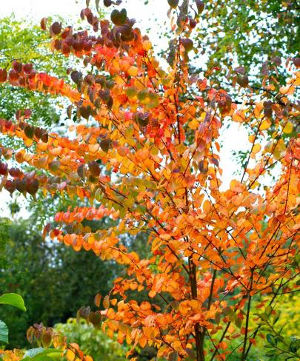
The organisers advised that as we were a smallish garden with limited parking we should open by appointment. Our first visitor came on a very sunny morning and we talked plants for two hours. It was delightful and we discovered she was a “scout” for her garden outings group and her closing remarks were “I’ll be back”. Her words were correct because some weeks later she returned with a big party, again the weather was perfect. Just what one wants to admire plants and surroundings. The visitors could sit and chat until finally their octogenarian leader bustled them off to their pub lunch. Her friends did enjoy themselves.
As you would expect, I must tell you of the other side of the coin. Three dates stand out in June – 7th, 11th and 28th. These were the wettest of the month. Thunder had started at 9 am on the 28th and we knew friends were travelling from Solihull. We expected the phone to ring to cancel but instead they brought two more friends who proved to be very keen garden enthusiasts. It was not actually raining at the moment of their arrival so a wise decision was made to delay coffee and view the garden immediately. Once the storm got underway we chatted happily and they were unable to get back into their car to return home until 1.30 pm. Our rain gauge had a reading of 18mm that morning. The other grim weather story was when another group came on the evening of 11th June. Rain had been falling in the early morning and continued without ceasing the whole day. Again, waiting for the phone to ring, and it did, they said they were coming still and made the most of the dire conditions. We squeezed as many as possible we could seat in our garden room, and the overflow sat in the sitting room with the gas fire on! This party will definitely remember that summer visit.
We found all visitors asked questions and we had prepared a brief set of photographs describing the history of the garden. We found this preferable to a pile of albums - too numerous to study. Most people just need a summary, in our case photographs in intervals of 10 years, as we have gardened here for a long time. We had provided a plant table as we have found most people like to make a purchase as a reminder of the garden.
Finally, in 2012, as fellow gardeners will have noted, certain plants have benefited from so much moisture during the “summer months”. Foxgloves have reached nearly 3 metres and clematis have been superb. One odd phenomenon has been our Cercidiphyllum japonicum which has had two sets of leaves in one season. We wonder if it will flourish next year, as most of the lower branches have died this year.
We conclude that in view of the fact that 2012 has been the wettest summer for 100 years we have fared pretty well, and are anticipating a less challenging gardening year in 2013!
Continuing this theme, Win Botterill wrote to us in mid-September:
“I wonder if anyone else is growing giant cosmos (perhaps they are too common for many expert HPSers)? I hope it’s the summer we have had and not some GM strain I have acquired … I have one which was 7ft 6” before it flowered. It’s still growing – in fact they are all much larger than usual.”
Can anyone beat that? Ed.
Worcestershire Group will be hosting this event on behalf of the Hardy Plant Society at Pershore College, Avonbank, Pershore, Worcestershire.
| 10.00-10.30am | Registration, coffee/tea and biscuits, plant sales |
| 10.45 | Welcome and introduction |
| 11.00 | Lecture: ‘Bordering on insanity’ - Timothy Walker |
| 12.00pm | Question time |
| 12.15 | Plant Auction |
| 12.30 | Buffet lunch, tea and coffee, plant sales |
| 1.45 | ANNUAL GENERAL MEETING |
| 2.45 | Tea, coffee and biscuits |
| 3.15 | Lecture: ‘Fabulous Foliage - A Foil for Flowers’ - Dr Andrew Ward |
| 4.30pm | Raffle draw and close |
A number of nurseries will be invited to sell plants. There will be an opportunity to purchase HPS booklets and badges. A buffet lunch and provision to take your own lunch has been organised. Further details will be available on the HPS website in November 2012 and a booking form together with directions to the venue will be available in the February 2013 HPS Newsletter. The likely cost for the day will be around £10 to £11 excluding buffet lunch.
To host this event Worcestershire group will require help on the day with the following:
Further details and names to John McGhee or at the meeting.
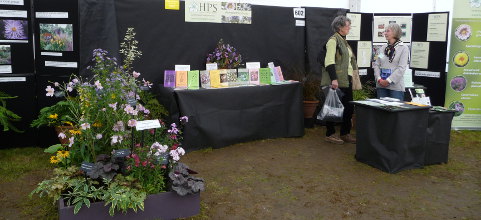
Congratulations to those members of HPS Worcestershire Group who once again designed and manned a stand at the Malvern Autumn Show for which they were awarded third prize in the National Plant Societies Group. The exhibit featured a small horticultural display but was mainly aimed at showing the work of the Hardy Plant Society. More photographs and details are available on the HPS national website
Could members please consider taking their turn to help in the kitchen, or bring a cake to our meetings, to save it being left to the same people each time. A rota will be left out at the December meeting for next year’s programme. Should you put your name down and find you are unable to attend the meeting after all, you can always swap with another member or contact me and I will sort it out. Thank you.
I tend to accumulate plant catalogues, not obsessively like some people collect postage stamps, or twitchers tick off bird sightings, but occasionally, picking them up when an opportunity occurs.
I very much enjoy browsing through them in a quiet moment, indulging in a little ‘make-believe’ by filling the garden with wonderful exotic plants, before a glance out of the window brings me back to earth.
Of course catalogues vary enormously, reflecting perhaps the personality and dedication of the author. Some are little more than a slightly amplified list of plants, whilst the best are a mine of information about the growing habits and recommended cultivation of the plants on offer. Some are lavishly illustrated, but, although this can be helpful, they need to be treated with caution as the pictures of the blooms are nearly always considerably enlarged, and the reality of a rather insignificant flower, following purchase, can be very disappointing.
There are hundreds of catalogues produced and I have only a small percentage, but these are a few favourites based on experience.
Of the specialist nurseries, David Austin for roses, Bouts of Inkberrow for violas and pansies, Pictons of Old Court Nurseries on the far side of the Malverns for Michaelmas daisies, and Thorncroft’s in Norfolk for clematis all have excellent informative catalogues and sell good healthy plants.
Amongst the more general hardy plant nurseries, Elizabeth MacGregor way up in Scotland has a fairly basic catalogue but has earned a reputation and a loyal following for good quality plants. Elizabeth used to be a viola specialist, but has expanded her range to cover a wide variety of plants. Our daughter, who lives in Cornwall, buys many of her plants on the premise that if they survive in Scotland they will surely flourish in Cornwall! Long Acre Nurseries in Somerset concentrate on plants for shady positions and produce a useful detailed catalogue. Their plants are well grown and of a good standard. Down in Hampshire, Marina Christopher runs Phoenix Garden Plants. Marina was at one time in partnership with John Coke (pronounced Cook) at Green Farm Plants in Bentley, but around the turn of the millennium decided to set up a nursery on her own and moved to a site a few miles down the road. She is a much respected plantswoman who has taken part in a number of plant-hunting expeditions. Her catalogue contains an interesting collection of plants, the majority of which have been personally trialled. Recently Marina wrote a book called ‘Late Summer Flowers’, a subject not covered before, which is packed with first-hand knowledge and advice. It is published by Francis Lincoln and is available in paperback for £16.99. It deserves to be better known and I would thoroughly recommend it.
My favourite catalogue for many years was Beth Chatto’s, produced for her nursery ‘Unusual Plants’ in Essex. She wrote about her plants in such detail that it became a useful reference book. Recently, when I phoned for a copy of the latest print, I was disappointed to receive a much truncated version.
Earlier this year I broke one of my golden rules, namely, not to be seduced by any of the many colourful collections featured in the advertising sections of the papers and gardening magazines, and purchased an interesting selection of salvias promoted by Hayloft Plants of Pensham near Pershore. The five plants arrived within a few days, small seedlings or rooted cuttings, a few inches high and neatly slotted into a plastic box. Potted on, they grew amazingly quickly and all have flowered well and provided cuttings for next year. To name but one, Salvia ‘Amistad’, with similar growth to S. ‘Indigo Spires’ but darker purple flowers and a slightly shorter spike, is really nice. I would mention that a fellow HPS member also fell for this collection and was equally pleased with the results. Later, I bought a coreopsis offer from Hayloft with a similar satisfactory outcome. Hayloft have a well-illustrated catalogue, sensibly limited in scope, with the emphasis being on the supply of multiples of young plants.
In my opinion, the best of all the hardy plant catalogues is the ‘inimitable’ Bob Brown’s for his Cotswold Garden Flowers nursery not far away in Badsey. The Oxford Dictionary defines ‘inimitable’ as ‘impossible to imitate’ and that just about sums him up. His current catalogue runs to 129 pages, listing over 2,000 plants, surely the widest selection anywhere in the country. He offers 47 different agaves, 31 kniphofias, 24 nerines, 66 sambucus etc. Bob’s descriptions are succinct, to the point, and often include some personal observations, such as ‘sumptuous and easy’; ‘lovely and persistent’; ‘sounds stunning doesn’t it?’ and so on. He scores plants he has grown and formed an opinion on out of ten, useful when uncertain which variety to choose, but must surely result in plants scoring ten being sold in preference to alternatives with lower marks. If you think you know a lot of plant names the range of the selection is challenging in the extreme. How about AMORPHOPHALLUS, ANISACANTHUS, BRAHEA, CHLORANTHUS, DICLIPTERA, HESPERALOE, MOEHRINGIA, PASITHEA, SCADOXUS and THLADIANTHA? Just a selection of plants unknown to me. One further feature of Bob’s catalogue is that it is sprinkled with a number of amusing witticisms. If you haven’t visited his nursery do go. You may not find the plant you are looking for, as they are not all available all the time, but I guarantee you will find something else and probably come away with more than you intended.
[Do you know any of the 10 'challenging' plants - they're pictured below. Click in a yellow box to find out which is which.]




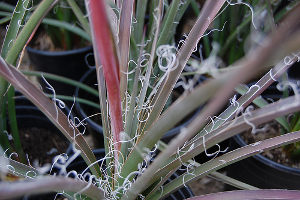

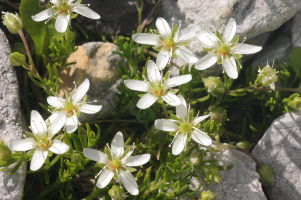



Writing in the gardening supplement of the Daily Telegraph recently, Mary Keen deplored the fact that Derry Watkins of Special Plants, a nursery in Wiltshire, had decided that from next year she was not going to produce a paper catalogue, her plant list being entered on the internet only. Mary hoped that this departure would not escalate and be adopted by other nurserymen and women. I must say I do agreed with her. To lose the pleasure of leafing through a tangible paper catalogue to words on a screen would be, for me, a very sad day.
I had always wanted to see the bulb fields of Holland so this year we decided to combine a visit with another favourite of mine, boats, and booked a few days holiday just after Easter on a river barge hotel. We flew to Schipol then were transported to the Prinses Irene, our boat, moored in the centre of Amsterdam and spent the afternoon strolling the streets attempting to avoid the cyclists and trams – not always easy. I marvelled at the bags of tulips for sale in April although one person who bought some told me they were 'specially treated to flower in a month'. I wonder if they did? In the evening we had a cruise along the canals admiring the houses and churches. Next morning we were off to Aalsmeer to see the flower auctions. Although we were too late to see the actual auctions, which take place in what appear to be lecture theatres with every seat equipped with a computer, we could see the warehouse area from an overhead walkway. It was immense, the size of 25 football pitches we were told, with trolleys of flowers whizzing everywhere. This is where those large Dutch lorries of flowers we see over here come from. Then we were off to a clog and cheese farm and then back to the barge where we ate lunch whilst setting sail for Arnhem. A pleasant afternoon ensued sitting on the sun deck (and, yes, there was sun) while the barge negotiated huge locks.
Next morning we were on the move at 6 o'clock to dock at Nijmegan then by coach to Floriade 2012 at Venlo, billed as a World Horticultural Exhibition and held only every 10 years. Perhaps I expected too much, perhaps it was because the day was very cold and grey, but I was disappointed. In fairness, it had only just opened so the outside flower beds were not at their best and most floriferous, and construction work was still in progress in one part, but it didn't do it for me. There were various pavilions, some sponsored by countries, a cable car over the site and in the wood in the middle what I believe is called performance art – recordings of poetry (at least I think that's what it was!).
We were transported back to the boat at Dordrecht this time and next morning were off to Keukenhof, the bulb showpiece. What a spectacle – 7½ million bulbs in a delightful parkland setting with the sun shining. Bed after bed of tulips, rivers of blue muscari running through banks of daffodils, small show gardens, pavilions showcasing various flowers such as gerbera, and a windmill. And this park is only open for a few months each year to show off Dutch bulbs. Another plus is that it is surrounded by the bulb fields where we saw long horizontal lines of colourful flowers, all sadly waiting to be decapitated so the bulbs can be harvested. A brilliant end to a delightful holiday as we were then back to the airport for our flight home.